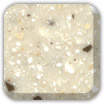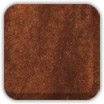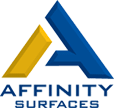Solid surface is an acrylic material manufactured into flat sheet panels and designed for use in interior and exterior applications. It is suitable for a wide variety of residential and commercial applications including kitchen counter tops and bathroom vanities, restaurant table-tops and work surfaces, hospitality areas, healthcare, banks and other corporate environments.
Solid surface sheets may be bonded to each other to create a continuous, seamless surface that is suitable for both horizontal and vertical use. Most solid surface materials combine two main ingredients: a natural mineral, which serves as the filler, and a resin, which serves as the binder. These are combined and then cast in a curing process that results in a sheet or a shape.
The most common mineral is alumina tri-hydrate, or ATH. ATH is a refined form of bauxite ore and can comprise up to 75 percent of a sheet of solid surface. Bauxite is a form of clay.
ATH is chemical and stain resistant, water-resistant, fire resistant, translucent and is hard enough to give impact-resistance, but soft enough to be machinable.
Other materials have been used as fillers for solid surface. Calcium carbonate glass fibers and even recycled newsprint have all at one time been used as fillers.
Two main resins used in the manufacturing of solid surface are acrylic and polyester. A purely acrylic-based resin yields a sheet that is thermoformable. It can be heated, bent into a new shape and cooled without any loss of performance characteristics.
Polyester resins, including those that are mixed with acrylic, are used in demanding or high strength applications. With the addition of a catalyst, usually peroxide, the sheets are then cast and cured.
Casting of solid surface consists of mixing the resin with fillers and additives. The mix is poured into an open mold. Occasionally, molds are closed for products with shape. In casting, air bubbles should be avoided by either adjusting the viscosity of the mix or vibrating the casting table. Air bubbles in the material cause voids once the material is cured.
Some solid surfaces cure in the open air. Steam or ovens are sometimes used for curing. Many polyester resins require a heating-cooling cycle after curing, which increases the degree of cure. An improperly controlled cure can cause air bubbles appearing in the material, which effectively ruin it as a solid surface. Carefully controlling temperatures during curing is an effective way of reducing this risk.
Features and Benefits
• Durable: resists chipping and cracking and retains its beauty
• Renewable: scratches, cuts and burns can be sanded away
• Available in classic solid colors and versatile patterns
• Homogeneous composition for color and pattern retention throughout the thickness of the sheet
• Offers seamless, one-piece appearance
• Stain-resistant and easy-to-clean
• Nonporous and hygienic: dirt can’t be trapped, liquids won’t penetrate, bacteria and fungi won’t grow
Article Source: Moden Woodworking




